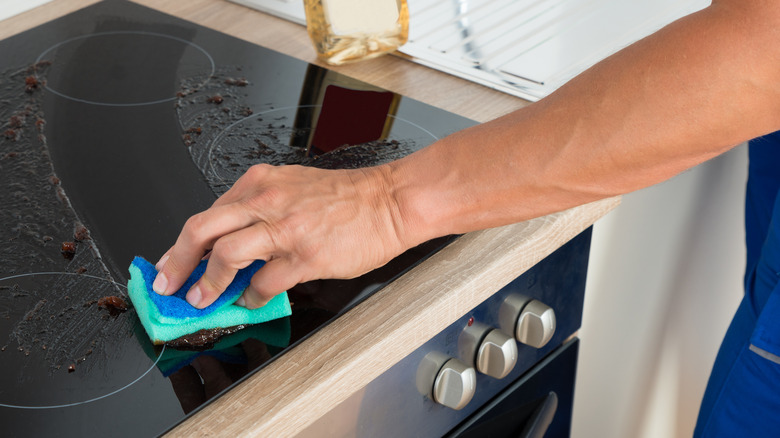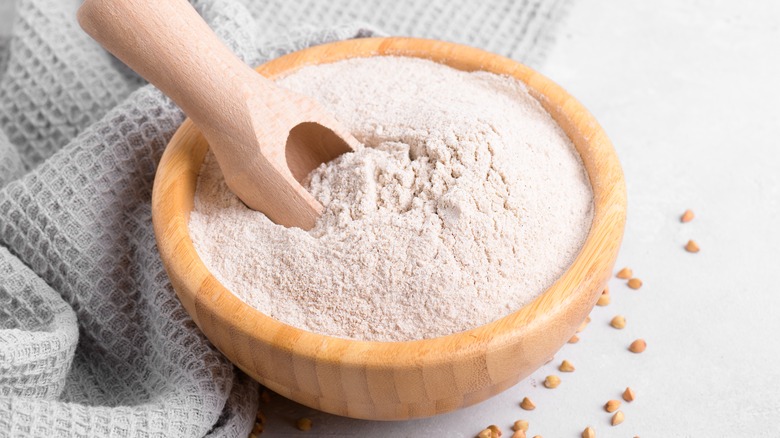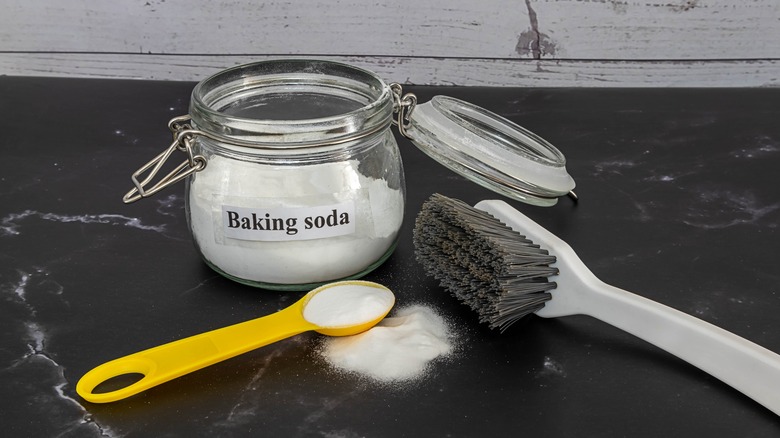The Staple Pantry Ingredients You Can Use To Clean Up Cooking Oil Spills
It's amazing how the solution to most messes in the kitchen can be found in the very same room of your house. In fact, most of the clean up can be done using a handful of nifty cooking ingredients. The same baking soda that you use to whip up moist cakes and airy breads? It can take care of stubborn grease or polish rusty baking pans. And then there's lemons that are the key to good-as-new ovens, clean coffee makers, and descaled kettles.
Even if you've splashed some hot oil on your stove or countertops, fret not, the solution is right there in the pantry — all you need is salt, flour, and baking soda.
Oil is made up of hydrophobic molecules, which means that water does not mix well with it. That is why those greasy splatters aren't often erased when cleaning with just a damp paper towel alone. On the other hand, flour and salt can absorb oil spills and mitigate the area of damage, and then baking soda can take care of the rest, including getting rid of any stubborn stains that may have built over from weeks of unattended grease. There are a few things to keep in mind when using these kitchen staples to clean up oil spills, especially when considering the kind of mess and the surface it's on.
When to use flour or salt to clean up oil spills
Let's say that you've knocked over an entire open bottle of oil; it's likely going to spill into a huge pool of grease that will slowly spread all across your sparkling countertops, unless you act fast. That's when flour or salt can help minimize the mess. Flour is made of two things — starch and gluten — both of which absorb liquids over their weight. When you throw a fistful of flour on the oil spill, the flour will quickly absorb the liquid and stop the running grease right in its tracks. Salt will similarly absorb oil spills and prevent them from spreading any further.
To use these kitchen staples to clean up oil spills, all you have to do is scoop out a generous mountain of either one over the liquid (regular salt or all-purpose flour will do). Leave the powders for a few minutes to do their jobs while also gently pressing down on them so that they can absorb as much liquid as possible. Once you notice the salt crisping up or the flour turning into a clump, all you need to do is scrape the mush off the surface and give it all a quick wipe-down.
While salt and flour work on just about every surface including sinks, ovens, and stovetops, salt can be mildly abrasive so when in doubt, it's best to stick to flour. Additionally, this method only works if the oil spill hasn't dried up yet, in which case, you're going to need a more heavy-duty cleaner like baking soda.
How to use baking soda to get rid of oil spills
Whether you're a baker or not, baking soda is a handy ingredient to have in your pantry at all times because it can clean just about anything in the kitchen, including cooking oil spills. Baking soda is essentially an alkaline substance which means, it can break down even dried, stubborn grease that's stuck onto notoriously hard-to-clean surfaces like ovens, countertops, stovetops, or pots and pans. To clean up oil spills using this method, you should dip a sponge in a paste of baking soda and water — using roughly 1 cup water for every 3 tablespoons baking soda — and gently rub the grease off. Alternatively, you can also spread the paste over the oil spill, leave it overnight, and wipe it off the next morning with the help of some vinegar.
The only thing to be mindful of is that baking soda may look harmless but it can be pretty abrasive and damage certain surfaces. It's best to keep baking soda away from glass, mirrors, gold-plated utensils, and even marble countertops. It's also best to leave the cleaning to another device if the oil spills are on aluminum cookware or ceramic stovetops. Baking soda can oxidize aluminum and scratch ceramic surfaces while leaving behind a layer of white that will be even harder to get rid of than the oil itself.



